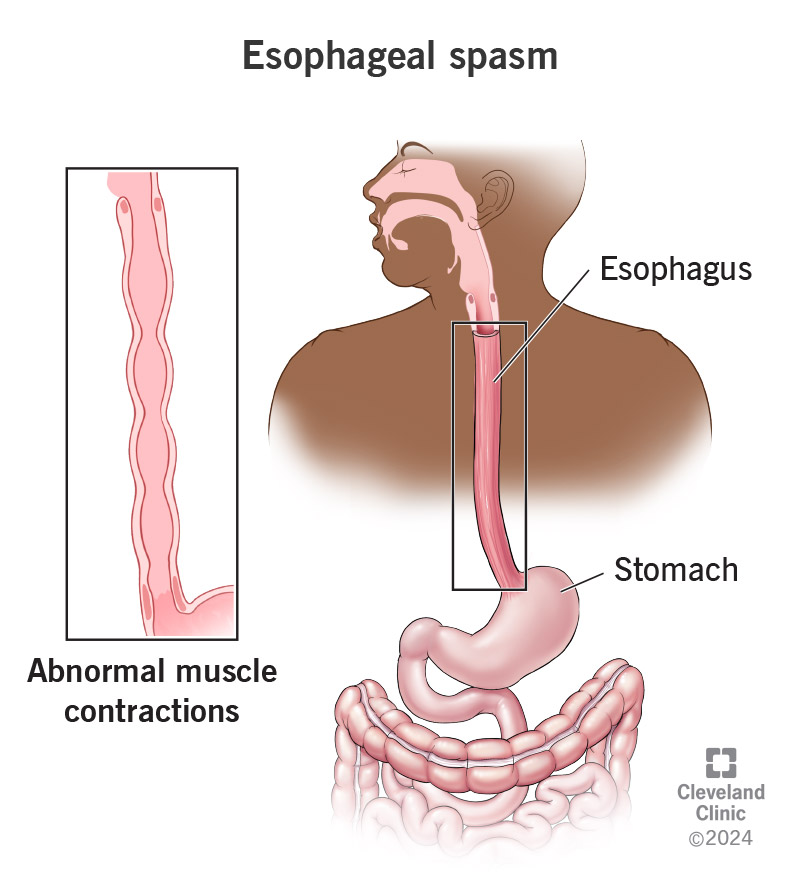Esophageal spasms are problems with muscles in your esophagus, the tube that takes food and drink to your stomach after you swallow. Spasms may cause minor to severe symptoms, including difficulty swallowing and chest pain. Medication or other therapies often help. Surgery is rare. If you have severe chest pain, seek medical care right away.
Advertisement
Cleveland Clinic is a non-profit academic medical center. Advertising on our site helps support our mission. We do not endorse non-Cleveland Clinic products or services. Policy

Esophageal spasms are abnormal muscle contractions in your esophagus (the tube that takes food and drink to your stomach after you swallow). These spasms make it harder for food to reach your stomach. They can be painful.
Advertisement
Cleveland Clinic is a non-profit academic medical center. Advertising on our site helps support our mission. We do not endorse non-Cleveland Clinic products or services. Policy
After you swallow, your esophagus muscles contract (flex and relax). When your esophagus works as it should, a wave of coordinated contractions moves food or liquid down to your stomach. This series of contractions is called peristalsis.
If you have esophageal spasms, these contractions don’t work correctly. Unusually powerful or ineffective muscle contractions in your esophagus can make it difficult for food or liquid to move through your esophagus. You may need more time to swallow, or you may regurgitate food.
There are two main types:
Esophageal spasms are rare. Medical experts estimate that distal esophageal spasm affects 1 person per 100,000 each year.
The two most common symptoms of esophageal spasms are difficulty swallowing (dysphagia) and noncardiac chest pain. But not all cases cause symptoms.
Advertisement
In some cases, esophageal spasms can cause chest pain that feels like you’re having a heart attack. Call your provider or seek immediate medical care if you experience worsening, unexplained chest pain for more than five minutes.
Esophageal spasm symptoms may be mild or severe. They may start at specific times, like after eating. Sometimes, they come on suddenly, out of nowhere. Once spasms start, they may last for a few minutes or more than one hour.
If you have esophageal spasms you may have chest pain that feels like:
With dysphagia, you may have:
Medical experts don’t know the exact cause. But some believe spasms happen because of faulty nerves that control how your esophagus muscles work.
In some instances, the faulty nerves may relate to excess acid in your esophagus. Many people with esophageal spasms also have chronic acid reflux (GERD). With this condition, stomach acid flows back up to your esophagus. It’s possible that the acid damages nerves in your esophagus.
Recent research suggests that people who use opioids for three months or longer are more likely to develop esophageal spasms.
More research is needed to determine the specific cause and risk factors.
Some people notice esophageal spasm symptoms tend to start:
But spasms can happen at any time.
Your healthcare provider will perform a physical exam to evaluate your symptoms. If you have chest pain, your provider may order tests, such as an electrocardiogram (EKG), to rule out heart disease.
Once they’ve ruled out heart disease, they’ll likely perform tests to rule out more common conditions that may be causing your symptoms. These include:
Advertisement
Tests used to diagnose esophageal spasms specifically include:
Esophageal spasms can be tricky to diagnose since several conditions cause the telltale symptoms: chest pain and trouble swallowing.
Once your provider determines your issue isn’t heart-related, they’ll rule out more common digestive system conditions with similar symptoms. These may include:
Esophageal spasm treatments focus on relaxing your esophageal muscles to relieve your symptoms. If esophageal spasms don’t cause symptoms, you may not need treatment.
Your healthcare provider may recommend any of the following to treat esophageal spasms:
Advertisement
Many people with esophageal spasms and GERD experience symptom relief for both conditions by taking proton pump inhibitors (PPIs). These medicines reduce stomach acid production.
Esophageal spasms related to opioid use often resolve after you stop taking them.
Esophageal spasms sometimes cause chest pain or trouble swallowing. But providers don’t consider the condition a serious threat to your health. Having trouble swallowing may make you worry about choking, but esophageal spasms aren’t life-threatening. Usually, they don’t interfere with your ability to get adequate nutrition.
Esophageal spasms don’t increase your risk of esophageal cancer or other serious conditions that can affect your esophagus.
The prognosis of esophageal spasms varies based on the severity of your symptoms. Many people experience few or minor symptoms from esophageal spasms. Treatments improve esophageal spasm symptoms considerably.
Your healthcare provider will monitor you to ensure any medications you take are working. They’ll schedule follow-up appointments post-surgery to ensure you’re healing as you should be.
Unfortunately, you can’t prevent the condition from happening altogether. Still, identifying and avoiding potential triggers (like certain foods or drinks) may help prevent spasm episodes from starting or worsening.
Advertisement
Esophageal spasms can sometimes cause symptoms similar to a heart attack. A heart attack can be life-threatening if not treated right away. Call 911 or seek immediate medical care if you experience:
Heartburn-like pain and trouble swallowing are often signs of a routine problem. Still, they may signal a more serious condition (such as cancer). Always check in with your provider if you experience similar symptoms for longer than two weeks.
Questions to ask include:
Left untreated, moderate to severe cases of esophageal spasms can negatively impact your quality of life. Symptoms may make eating, which should be an enjoyable activity, difficult. Chronic pain may lead you to withdraw from activities you enjoy or take an emotional toll. If heartburn, trouble swallowing or other esophageal spasm symptoms are causing trouble, ask your provider about treatment options. Always seek immediate medical care when you have unexplained chest pain.
Esophageal disorders can cause many symptoms, including heartburn or trouble swallowing. At Cleveland Clinic, we’ll find a treatment that works for you.

Last reviewed on 06/26/2024.
Learn more about the Health Library and our editorial process.